Geochemical and Dynamic Model of Repeated Hydrothermal Injections in Two Mesozoic Successions, Provençal Domain, Maritime Alps, SE-France
Abstract
1. Introduction
2. Regional Geology
3. Methods and Materials
4. Results
4.1. Field Observation
4.2. Petrography of the Triassic–Jurassic Succession
4.2.1. Middle Triassic Section
4.2.2. Middle-Upper Jurassic
4.3. Early and Late Diagenetic Stylolites
4.4. Chemical Composition (Major and Trace Elements)
4.5. δ18OVPDB and δ13CVPDB Isotopes
4.6. 87Sr/86Sr Data
5. Interpretation and Discussion
5.1. Paragenetic Sequence Related to Dolomitizing Fluids
5.2. Geochemical Evolution of Diagenetic Fluids
5.3. Impact of Basement–Fluid Interactions, Continental Riverine and vceanic Fluxes on Strontium Isotope Signatures
6. Conclusions
- The succession is extensively dolomitized with abundant breccia and zebra textures, and complex fracturing paths due to the influence of repeatedly injections of hydrothermal fluids.
- Three diagenetic settings are recognized:
- (i)
- An eogenetic realm with weak diagenetic imprints. This setting is confirmed by δ18OVPDB and δ13CVPDB values that fit the inverse “J” Lohmann curve and meteoric line models.
- (ii)
- A second mesogenetic setting in two phases, the first one started with the generation of wispy stylolites (“early dolomite”), and various networks of fractures as well as zebra and breccia fabrics. The fabrics are associated with a first generation of medium- to coarse-grained dominantly euhedral saddle dolomites (Type II) formed through the migration of hot dolomitizing fluids. This occured during early Cretaceous times and was related to the extensional and transtensional tectonics of the European paleomargin of the Alpine Tethys. In the second phase (our Type III dolomite), further physical brecciation and cataclastic fractures cross cut the Type II dolomite under deeper burial conditions with late stylolite-related fractures (tension gashes). The δ18OVPDB values become more depleted with subsequent increases in the saddle crystal sizes. The δ18OVPDB saddle dolomite values (up to −8.3‰ in Type II and up to −11.6‰ in Type III) suggest that at least two pulses of hydrothermal fluids during the precipitation of saddle dolomites occurred. The chemical composition of the successive saddle dolomites was progressively modified from nonferroan to ferroan-rich in an open system and the positive co-variant trends of 87Sr/86Sr vs. δ18OVPDB strongly support an origin from from hot fluids in a deep burial-reducing mesogenetic environment.
- (iii)
- The ultimate diagenesis is related to the late phase of calcite cement precipitation, synchronous with Fe and Mn depletion and extra-negative δ18OVPDB-δ13CVPDB values. A meteoric water under near-surface conditions during telogenesis and uplifting of the Triassic–Jurassic succession is inferred.
- The depletion and enrichment of radiogenic strontium signals could also be linked to the pulses of mid-oceanic hydrothermal fluxes and an input of riverine fluxes during the opening and closure of the North Atlantic Ocean, beside the involvement of hydrothermal fluids and meteoric waters on Triassic–Jurassic successions.
Author Contributions
Funding
Acknowledgments
Conflicts of Interest
References
- Machel, H.G. Concepts and models of dolomitization: A critical reappraisal. In The Geometry and Petrogenesis of Dolomite Hydrocarbon Reservoirs; Braithwaite, C.J.R., Rizzi, G., Darke, G., Eds.; Geological Society of London: London, UK, 2004; Volume 235, pp. 7–63. [Google Scholar]
- Fu, Q.; Quing, H. Medium and coarsely crystalline dolomites in the Middle Devonian Ratner Formation, southern Saskatchewan, Canada: Origin and pore evolution. Carbonates Evaporites 2011, 26, 111–125. [Google Scholar] [CrossRef]
- Land, S. The origin of massive dolomite. J. Geol. Educ. 1985, 33, 87–110. [Google Scholar] [CrossRef]
- Machel, G.; Mountjoy, W. Chemistry and environment of dolomitization: A reappraisal. Earth Sci. Rev. 1986, 23, 175–222. [Google Scholar] [CrossRef]
- Hardie, A. Dolomitization: A critical view of some current views. J. Sediment. Petrol. 1987, 57, 166–183. [Google Scholar] [CrossRef]
- Qing, H.; Mounjoy, W. Formation of coarsely crystalline, hydrothermal dolomite reservoir in the Presqu’ile Barrier, western Canada Sedimentary Basin. Am. Assoc. Pet. Geol. 1994, 78, 55–77. [Google Scholar]
- Al-Aasm, I.S. Origin and characterization of hydrothermal dolomite in the Western Canada Sedimentary Basin. J. Geochem. Explor. 2003, 78–79, 9–15. [Google Scholar] [CrossRef]
- Smith, B. Origin and reservoir characteristics of Upper Ordovician Trenton-Black River hydrothermal dolomite reservoirs in New York. Bull. Am. Assoc. Pet. Geol. 2006, 90, 1691–1718. [Google Scholar] [CrossRef]
- Lavoie, D.; Chi, G. Lower Paleozoic foreland basins in eastern Canada: Tectono-thermal events recorded by faults, fluids and hydrothermal dolomites. Bull. Can. Pet. Geol. 2010, 58, 17–35. [Google Scholar] [CrossRef][Green Version]
- Hardie, A. On the significance of evaporites. Annu. Rev. Earth Planet. Sci. 1991, 19, 131–168. [Google Scholar] [CrossRef]
- Iannace, A.; Gasparrini, M.; Gabellone, T.; Mazzoli, S. Late dolomitization in basinal limestones of the southern Apennines fold and thrust belt (Italy). Oil Gas Sci. Technol. Rev. d’IFP Energ. Nouv. 2012, 67, 59–75. [Google Scholar] [CrossRef][Green Version]
- Davies, G.; Smith, L. Structurally controlled hydrothermal dolomite reservoir facies: An overview. Am. Assoc. Pet. Geol. Bull. 2006, 90, 1641–1690. [Google Scholar] [CrossRef]
- Mohn, G.; Manatschal, G.; Muntener, O.; Beltrando, M.; Masini, E. Unravelling the interaction between tectonic and sedimentary processes during lithospheric thinning in the Alpine Tethys margins. Int. J. Earth Sci. 2010, 99, 75–101. [Google Scholar] [CrossRef]
- Barale, L.; Bertok, C.; Talabani, S.N.; d’Atri, A.; Martire, L.; Piana, F.; Préat, A. Very hot, very shallow hydrothermal dolomitization: An example from the Maritime Alps (north-west Italy–south-east France). Sedimentology 2016, 63, 2037–2065. [Google Scholar] [CrossRef]
- Durand, M. Permian to Triassic continental successions in southern Provence (France): An overview. Geol. Soc. Italy 2008, 127, 697–716. [Google Scholar]
- De Graciansky, C.; Lemoine, M. Early Cretaceous extensional tectonics in the southwestern French Alps: A consequence of North-Atlantic rifting during Tethyan spreading. Bull. Société Géologique Fr. 1988, 8, 733–737. [Google Scholar] [CrossRef]
- Dardeau, G.; Pascal, A. La régression fin-Jurassique dans les Alpes-Maritimes: Stratigraphie, faciès, environnements sédimentaires et influence du bâti structural dans l’arc de Nice. Bull. Bur. Rech. Géologiques Minières 1982, 3, 193–204. [Google Scholar]
- Debrand-Passard, S.; Courbouleix, S.; Lienhart, J. Geological synthesis of south-east France. Bur. Geol. Min. Res. Orléans 1984, 125, 615. [Google Scholar]
- McArthur, M.; Howarth, J.; Shields, A. Strontium isotope stratigraphy. In The Geologic Time Scale 2012; Gradstein, F.M., Ogg, J.G., Schmitz, M., Ogg, G.M., Eds.; Elsevier: Boston, MA, USA, 2012; Volume 2, pp. 127–144. [Google Scholar]
- Nelson, A. Significance of fracture sets associated with stylolite zones. Am. Assoc. Pet. Geol. Bull. 1981, 65, 2417–2425. [Google Scholar]
- Eren, M. Origin of stylolite related fractures in Atoka Bank Carbonates, Eddy County, New Mexico, U.S.A. Carbonates Evaporites 2005, 20, 42–49. [Google Scholar] [CrossRef]
- Jones, E.; Tarney, J.; Baker, H.; Gerouki, F. Tertiary granitoids of Rhodope, Northern Greece: Magmatism related to extensional collapse of the Hellenic orogen? Tectonophysics 1992, 210, 295–314. [Google Scholar] [CrossRef]
- Veizer, J.; Hoefs, J. The nature of O18/O16 and C13/C12 secular trends in sedimentary carbonate rocks. Geochim. Cosmochim. Acta 1976, 40, 1387–1395. [Google Scholar] [CrossRef]
- Veizer, J.; Ala, D.; Azmy, K.; Bruckschen, P.; Buhl, D.; Bruhn, F.; Carden, G.A.F.; Diener, A.; Ebneth, S.; Goddéris, Y.; et al. 87Sr/86Sr, δ13C and δ18O evolution of Phanerozoic seawater. Chem. Geol. 1999, 161, 59–88. [Google Scholar] [CrossRef]
- Katz, M.E.; Wright, J.D.; Miller, K.G.; Cramer, B.S.; Fennel, K.; Falkowski, P.G. Biological overprint of the geological carbon cycle. Mar. Geol. 2005, 217, 323–338. [Google Scholar] [CrossRef]
- Korte, C.; Kozur, W.; Bruckschen, P.; Veizer, J. Strontium isotope evolution of Late Permian and Triassic seawater. Geochim. Cosmochim. Acta 2003, 67, 47–62. [Google Scholar] [CrossRef]
- Jones, E.; Jenkyns, C.; Coe, L.; Hesselbo, P. Strontium isotopic variations in Jurassic and Cretaceous seawater. Geochim. Cosmochim. Acta 1994, 58, 3061–3074. [Google Scholar] [CrossRef]
- Gregg, J.M.; Sibley, D.F. Epigenetic dolomitization and origin of xenotopic dolomite texture. J. Sediment. Res. 1984, 54, 908–931. [Google Scholar]
- Sibley, F.; Gregg, M. Classification of dolomite rock textures. J. Sediment. Res. 1987, 57, 967–975. [Google Scholar]
- Salih, N.; Mansurbeg, H.; Kolo, K.; Gerdes, A.; Préat, A. In situ U-Pb dating of hydrothermal diagenesis in tectonically controlled fracturing in the Upper Cretaceous Bekhme Formation, Kurdistan Region-Iraq. Int. Geol. Rev. 2019, 0020–6814, 1938–2839. [Google Scholar] [CrossRef]
- Kretz, R. Carousel model for the crystallization of saddle dolomite. J. Sediment. Petrol. 1992, 62, 551–574. [Google Scholar]
- Nelson, A. Natural fracture systems: Description and classification. Am. Assoc. Pet. Geol. Bull. 1979, 63, 2214–2232. [Google Scholar]
- Morad, S.; Al Suwaidi, M.; Mansurbeg, H.; Morad, D.; Ceriani, A.; Papagoni, M.; Al-Aasm, I. Diagenesis of a limestone reservoir (Lower Cretaceous), Abu Dhabi, United Arab Emirates: Comparison between the anticline crest and flanks. Sediment. Geol. 2019, 380, 127–142. [Google Scholar] [CrossRef]
- Carraro, F.; Dal Piaz, V.; Franceschetti, B.; Malaroda, R.; Sturani, C.; Zanella, E. Note Illustrative della Carta Geologica del Massiccio dell’Argentera alla scala 1: 50.000. Mem. Soc. Geol. Italy 1970, 9, 557–663. [Google Scholar]
- Malaroda, R. L’Argentera meridionale–Memoria illustrativa della “Geological Map of Southern Argentera Massif (Maritime Alps) 1:25,000”. Sci. Géologiques–Mémoires 1999, 51–52, 241–331. [Google Scholar]
- Bigot-Cormier, F.; Poupeau, G.; Sosson, M. Dénudations différentielles du massif cristallin externe alpin de l’Argentera (Sud-Est de la France) révélées par thermochronologie traces de fission (apatites, zircons). Comptes Rendus l’Académie Sci. Paris 2000, 330, 363–370. [Google Scholar] [CrossRef]
- Wierzbicki, R.; Dravis, J.; Al-Aasm, I.; Harland, N. Burial dolomitization and dissolution of Upper Jurassic Abenaki platform carbonates, Deep Panuke reservoir, Nova Scotia, Canada. Am. Assoc. Pet. Geol. 2006, 90, 1843–1861. [Google Scholar] [CrossRef]
- Crampton, L.; Allen, A. Recognition of forebulge unconformities associated with early-stage Foreland Basin development—Example from the North Alpine Foreland Basin. Am. Assoc. Pet. Geol. Bull. 1995, 79, 1495–1514. [Google Scholar]
- D’Arti, A.; Piana, F.; Barale, L.; Bertok, C.; Martire, L. Geological setting of the southern termination of Western Alps. Int. J. Earth Sci. 2016, 105, 1831–1858. [Google Scholar]
- Lohmann, C. Geochemical patterns of meteoric diagenetic systems and their application to studies of paleokarst. In Paleokarst; James, N.P., Choquette, P.W., Eds.; Springer: New York, NY, USA, 1988; pp. 58–80. [Google Scholar]
- Allan, R.; Mathhews, K. Carbon and oxygen isotopes as diagenetic and stratigraphic tools: Data from surface and subsurface Barbados, West Indies. Geology 1977, 5, 16–20. [Google Scholar] [CrossRef]
- Nader, H.; Swennen, R.; Ottenburgs, R. Karst-meteoric dedolomitisation in Jurassic carbonates, Lebanon. Geol. Belg. 2003, 6, 3–23. [Google Scholar]
- Moore, H. Carbonate Diagenesis and Porosity. Dev. Sedimentol. 1989, 46, 338. [Google Scholar]
- Wright, P.; Harris, P. Carbonate Dissolution and Porosity Development in the Burial (mesogenetic) Environment. In Proceedings of the Oral presentation at American Association of Petroleum Geologists, Annual Convention and Exhibition, Pittsburgh, PA, USA, 19–22 May 2013. [Google Scholar]
- Salih, N.; Kamal, M.; Préat, A. Classical observations and stable isotopes for identification the diagenesis of Jeribe formation at Jambour oil Fields-Kurdistan Region-Iraq. Pet. Sci. Technol. 2019, 37, 1548–1556. [Google Scholar] [CrossRef]
- Shah, M.; Nader, H.; Garcia, D.; Swennen, E.R. Hydrothermal dolomites in the Early Albian (Cretaceous) platform carbonates (NW Spain): Nature and origin of dolomites and dolomitizing fluids. Oil Gas Sci. Technol. 2012, 67, 97–122. [Google Scholar] [CrossRef]
- Faure, G.; Assereto, R.; Tremba, L. Strontium isotope composition of marine carbonates of Middle Triassic to Early Jur assic age, Lombardic Alps, Italy. Sedimentology 1978, 25, 523–543. [Google Scholar] [CrossRef]
- Li, S.; Levin, E.; Chesson, A. Continental scale variation in 17O-excess of meteoric waters in the United States. Geochim. Cosmochim. Acta 2015, 164, 110–126. [Google Scholar] [CrossRef]
- Jones, E.; Jenkyns, C. Seawater strontium isotopes, oceanic anoxic events, and seafloor hydrothermal activity in the Jurassic and Cretaceous. Am. J. Sci. 2001, 301, 112–149. [Google Scholar] [CrossRef]
- Salih, N.; Mansurbeg, H.; Kolo, K.; Préat, A. Hydrothermal Carbonate Mineralization, Calcretization, and Microbial Diagenesis Associated with Multiple Sedimentary Phases in the Upper Cretaceous Bekhme Formation, Kurdistan Region-Iraq. Geosciences 2019, 9, 459. [Google Scholar] [CrossRef]
- Dong, S.; Chen, D.; Qing, H.; Zhou, X.; Wang, D.; Guo, Z.; Jiang, M.; Qian, Y. Hydrothermal alteration of dolostones in the Lower Ordovician, Tarim Basin, NW China: Multiple constraints from petrology, isotope geochemistry and fluid inclusion microthermometry. Mar. Pet. Geol. 2013, 46, 270–286. [Google Scholar] [CrossRef]
- Sanchez, G.; Rolland, Y.; Jolivet, M.; Brichau, S.; Corsini, M.; Carter, A. Exhumation controlled by transcurrent tectonics: The Argentera-Mercantour massif (SW Alps): Exhumation controlled by transcurrent tectonics in SW Alps. Terra Nova 2011, 23, 116–126. [Google Scholar] [CrossRef]
- Dumont, T.; Schwartz, S.; Guillot, S.; Simon-Labric, T.; Tricart, P.; Jourdan, S. Structural and sedimentary records of the Oligocene revolution in the Western Alpine arc. J. Geodyn. 2012, 56–57, 18–38. [Google Scholar] [CrossRef]
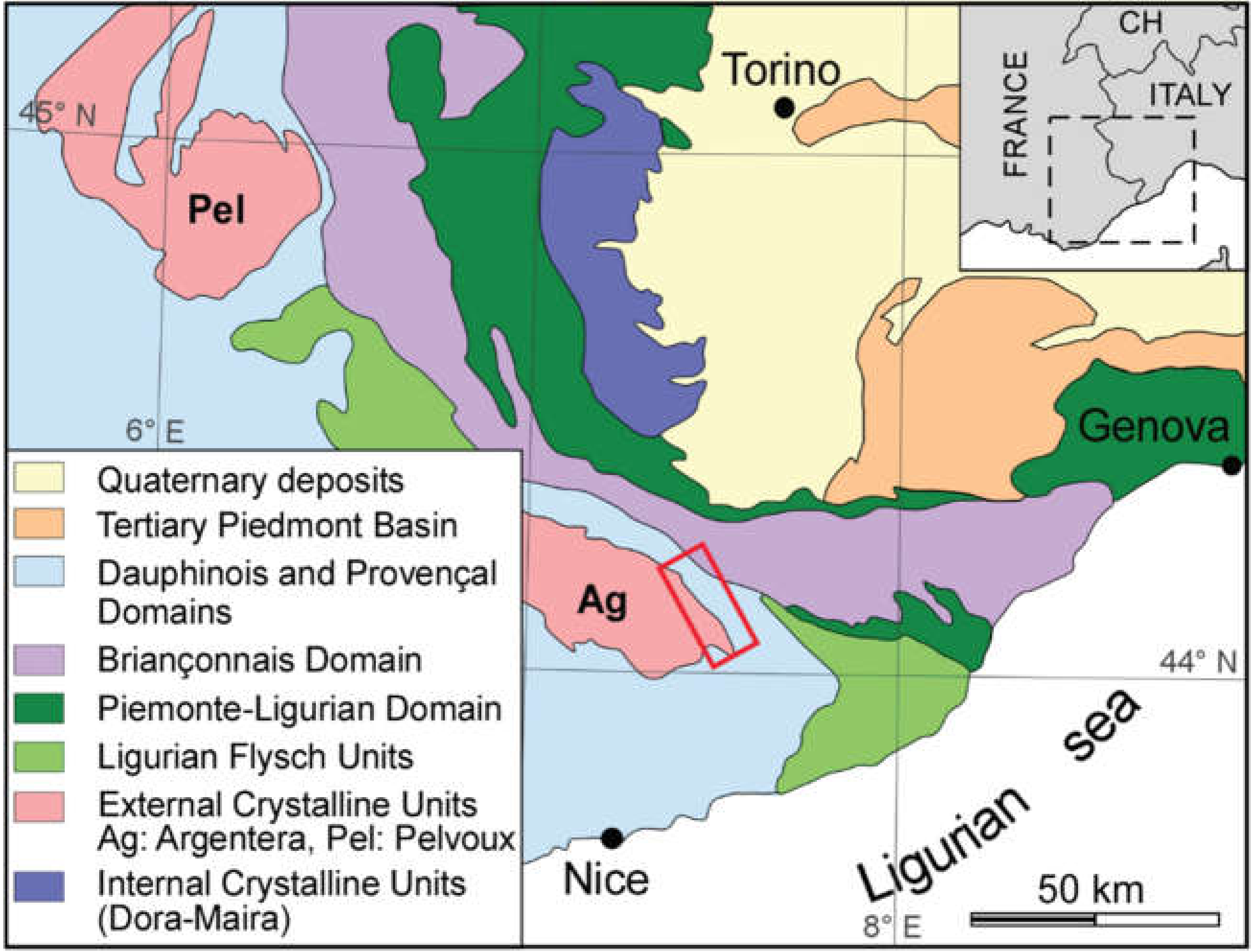

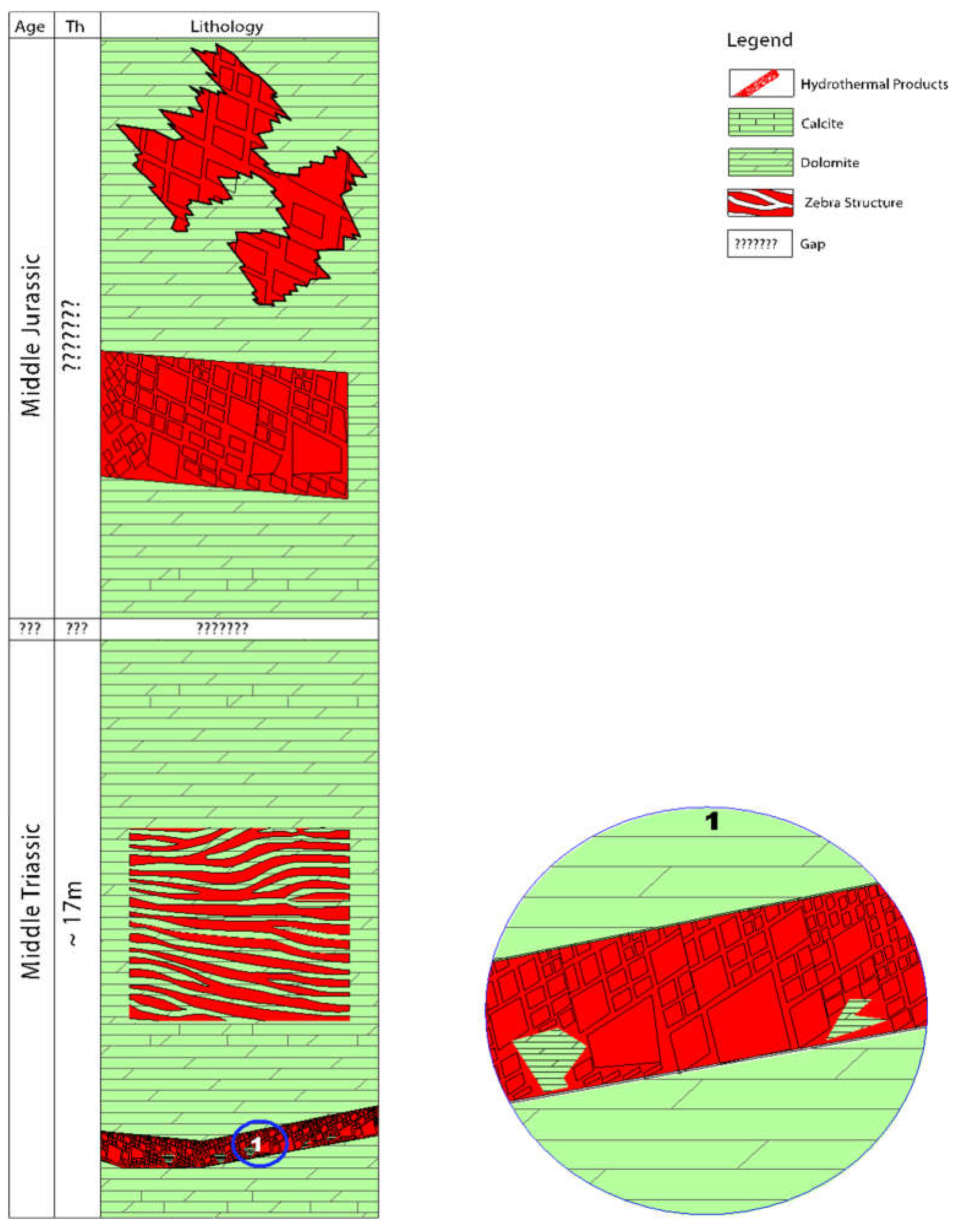
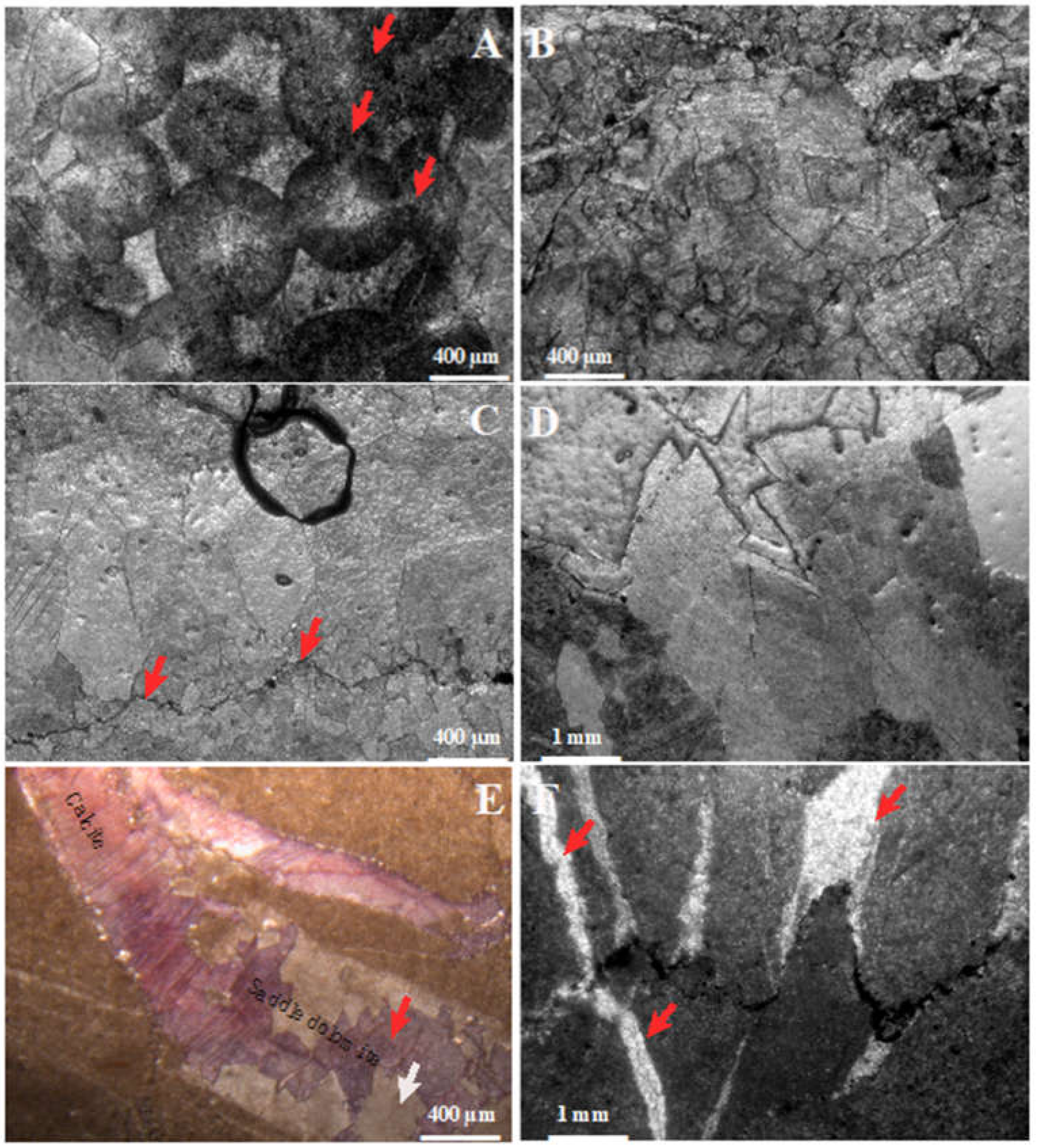
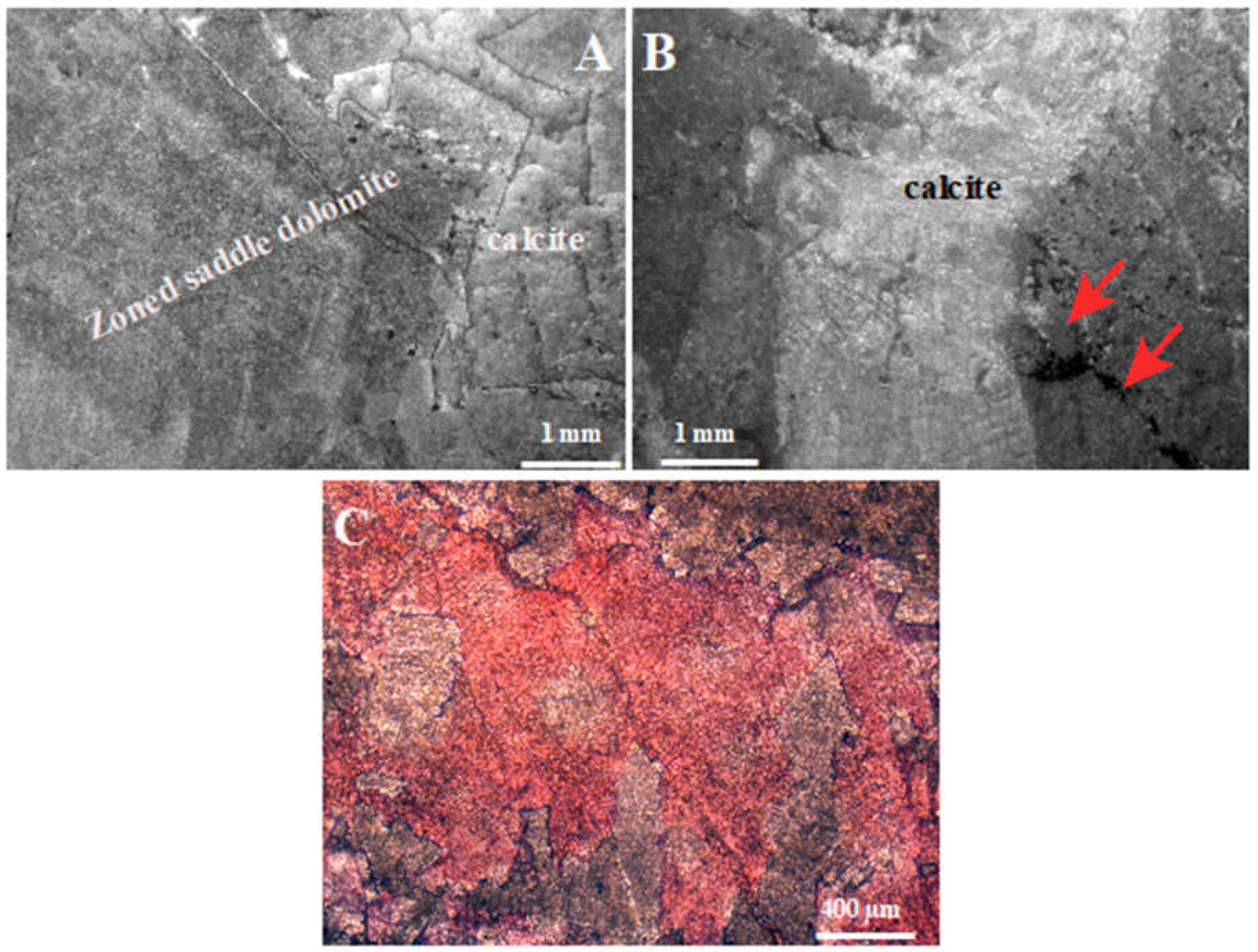

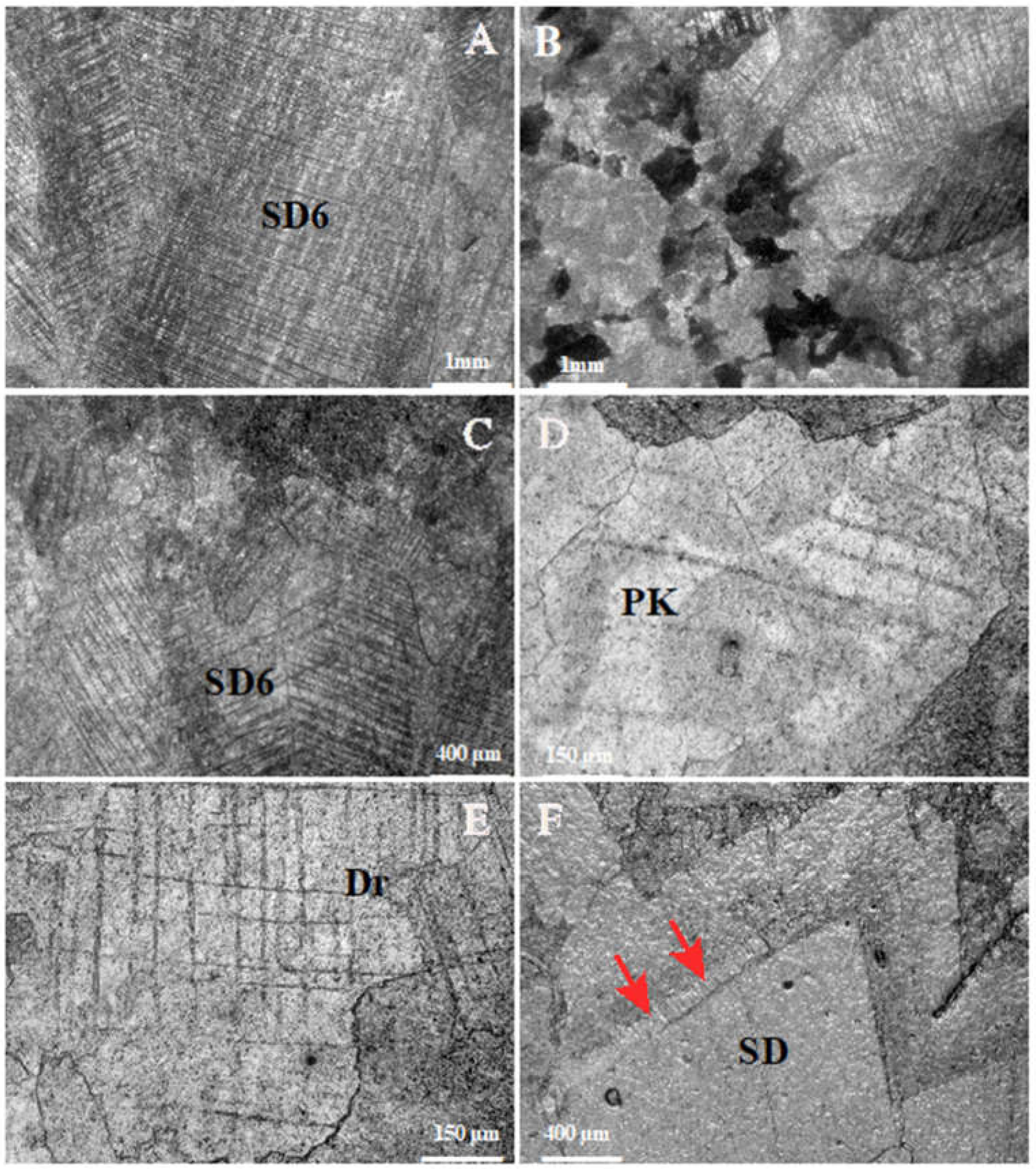
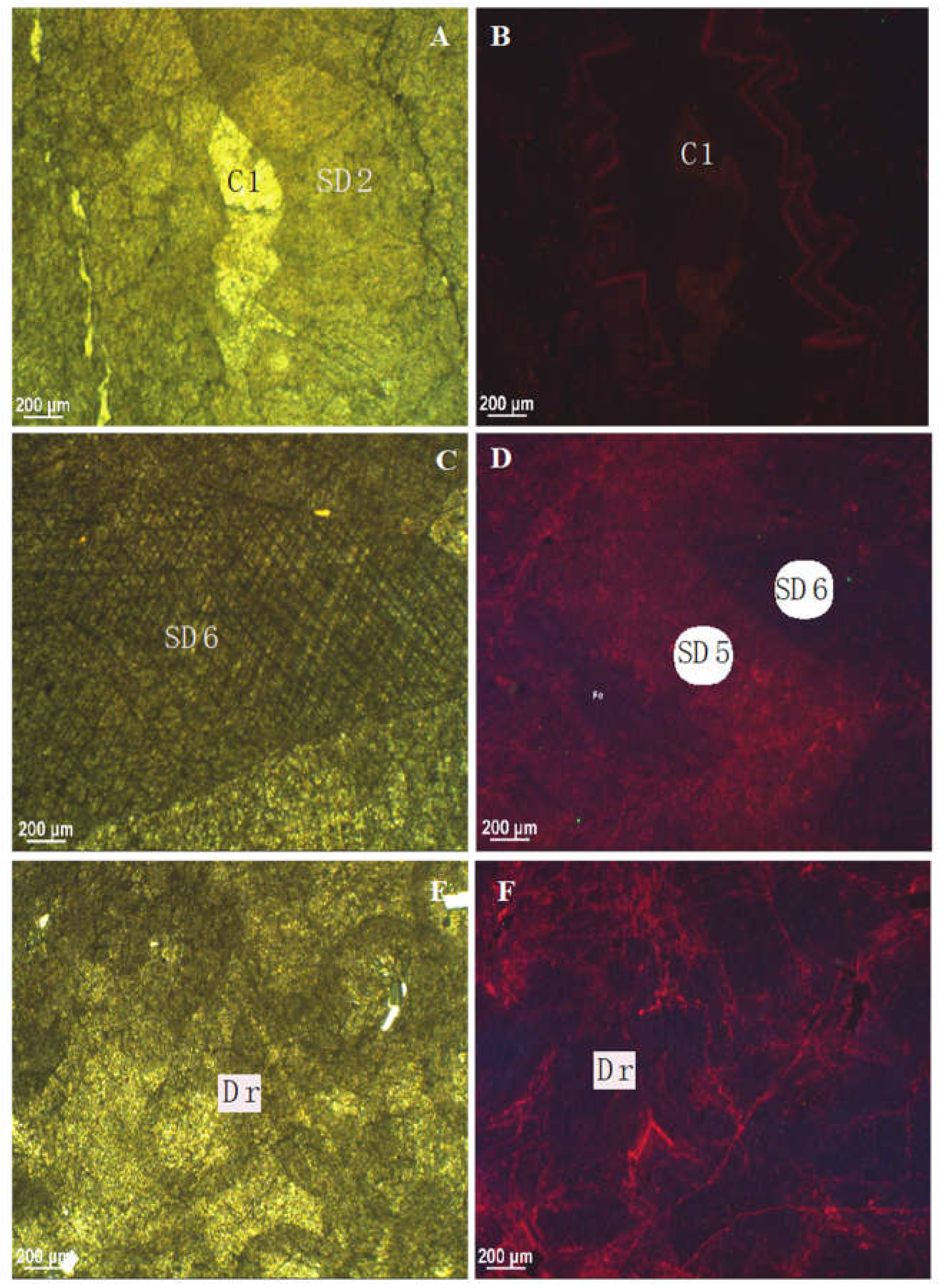
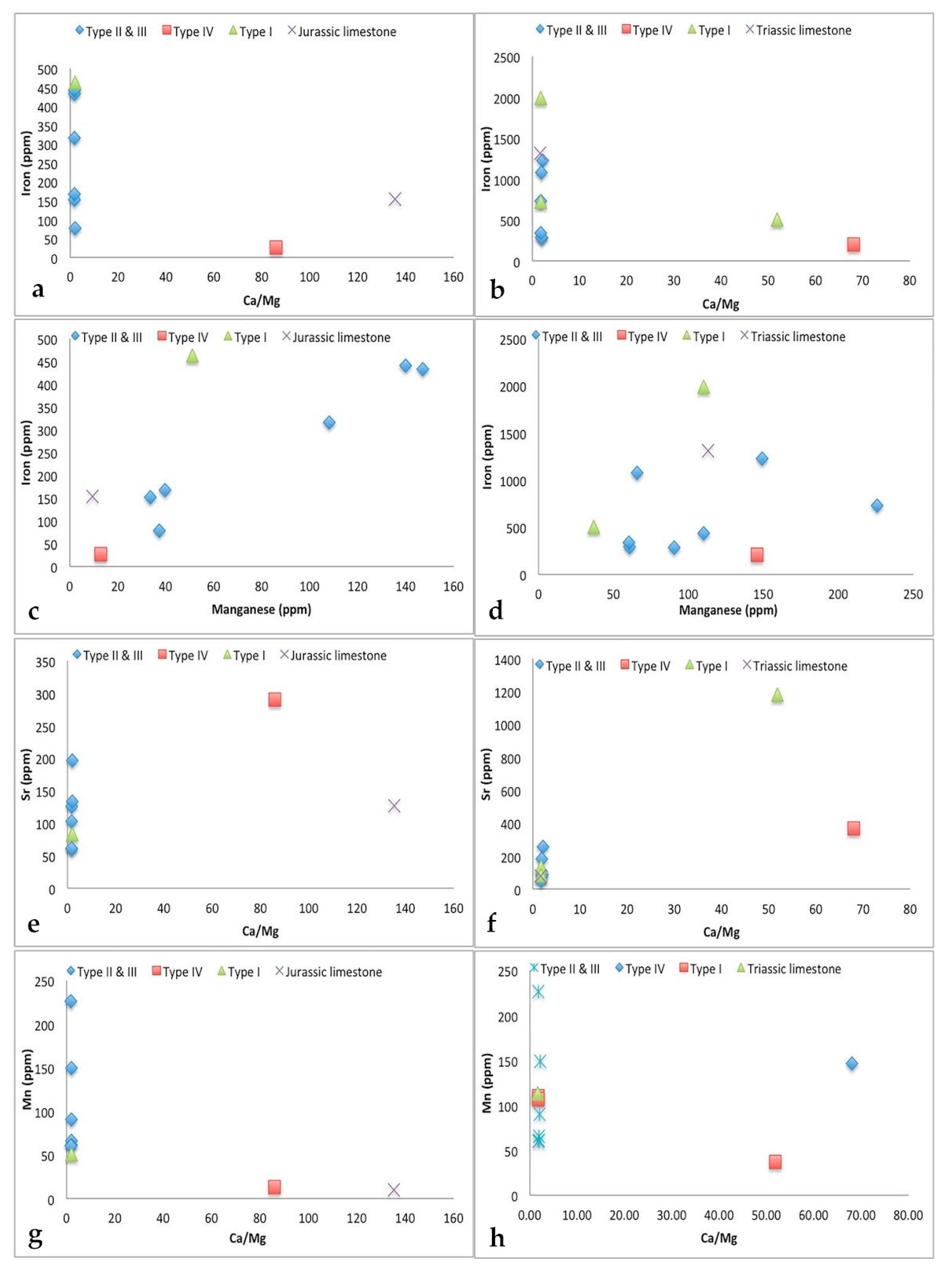
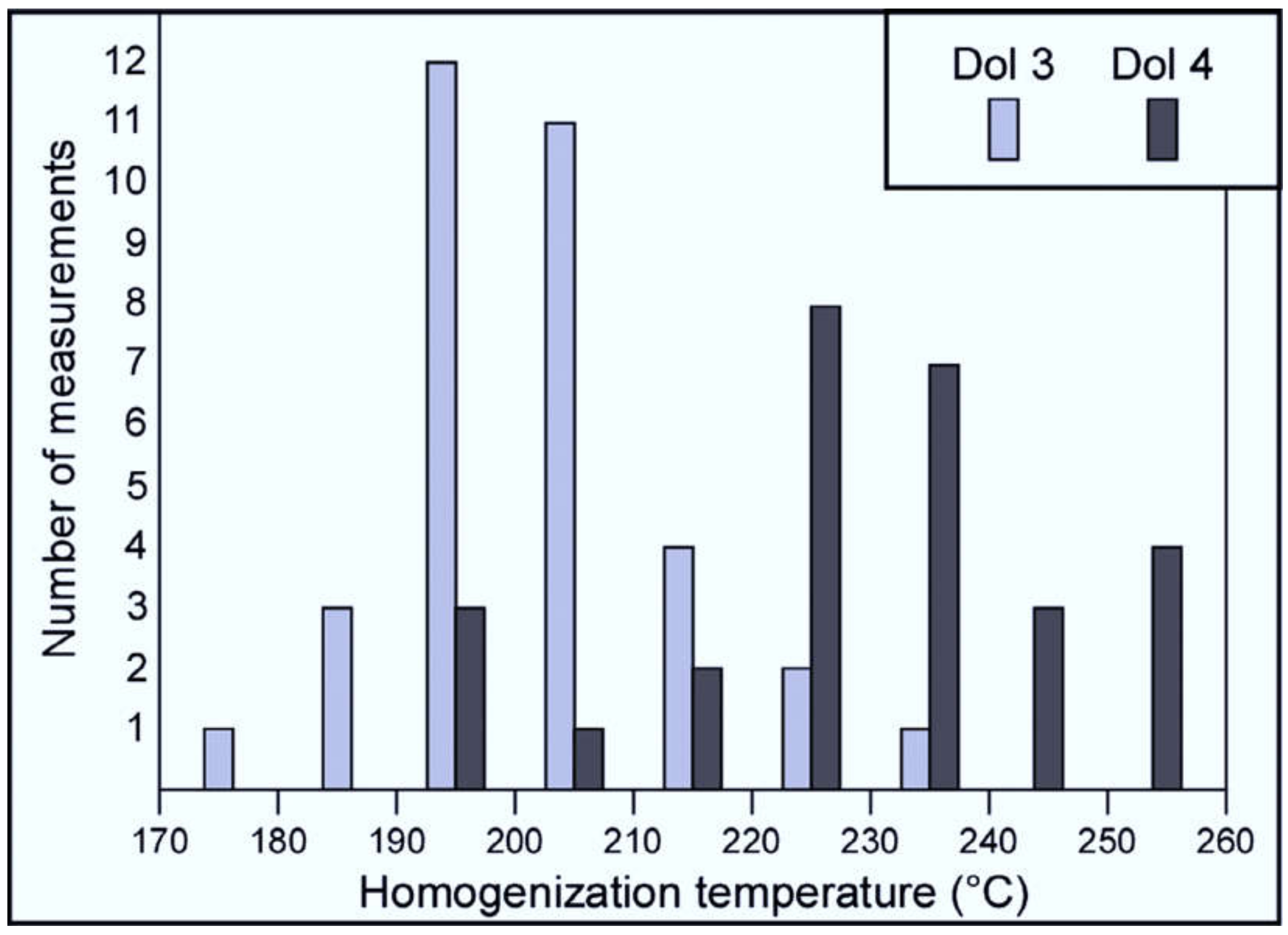
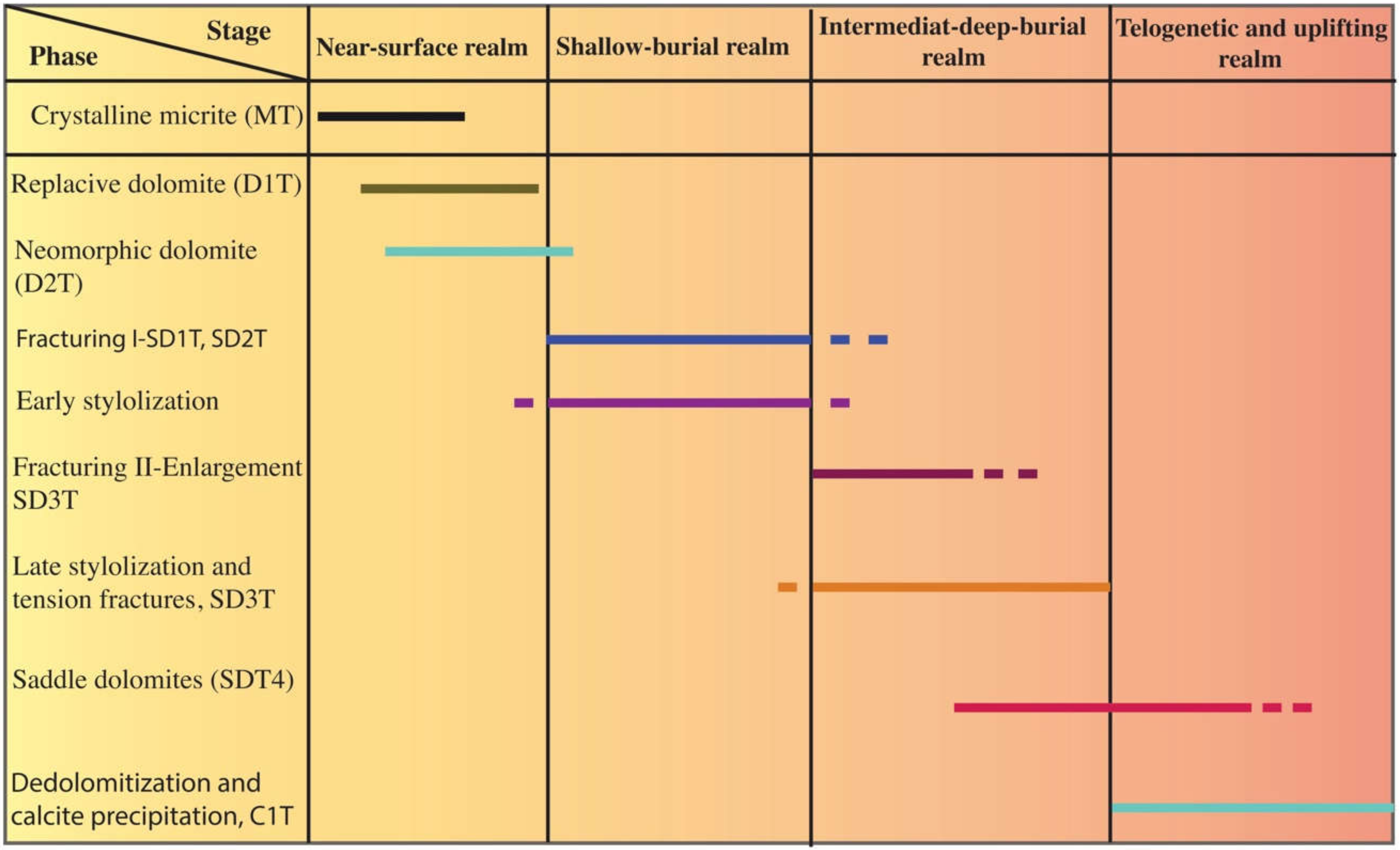

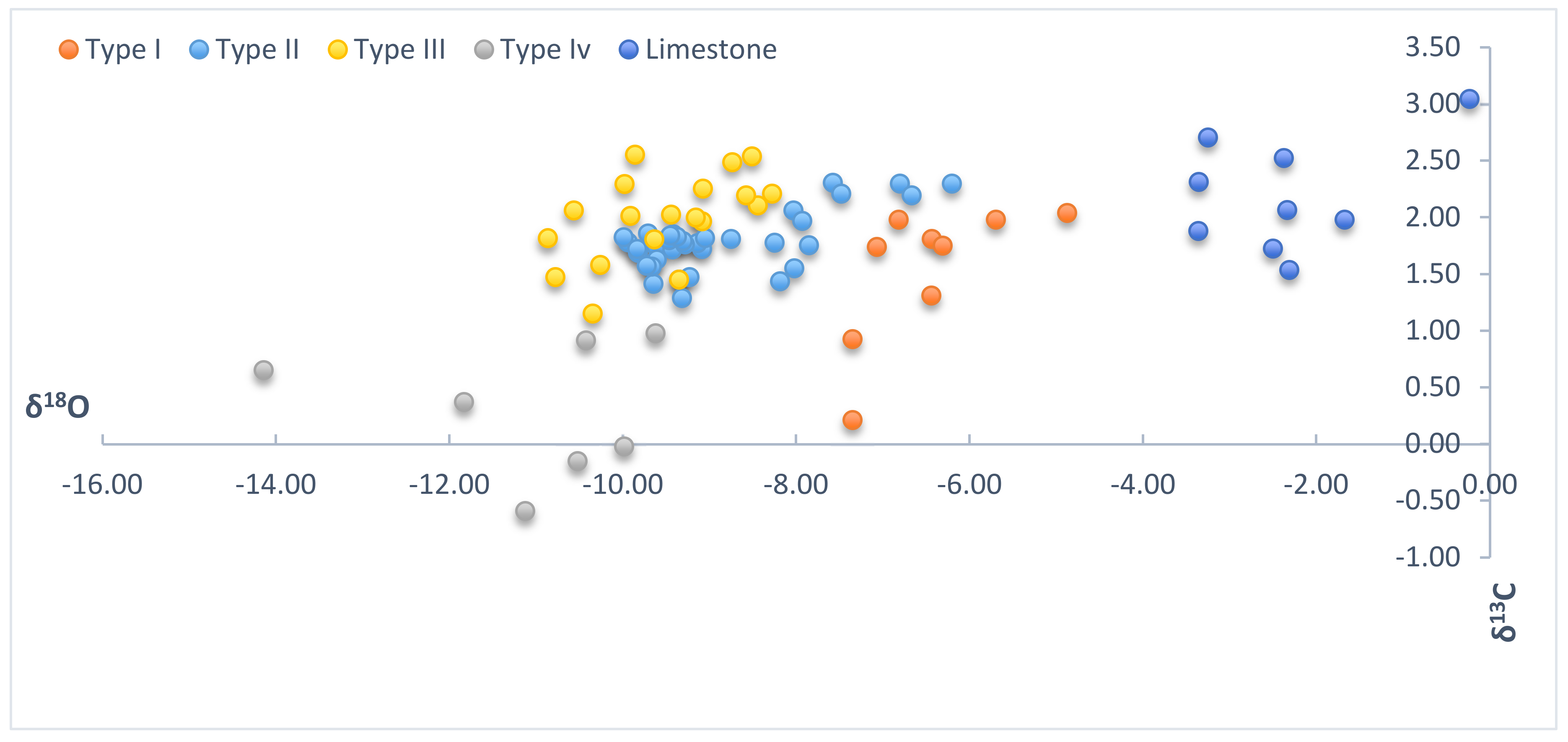

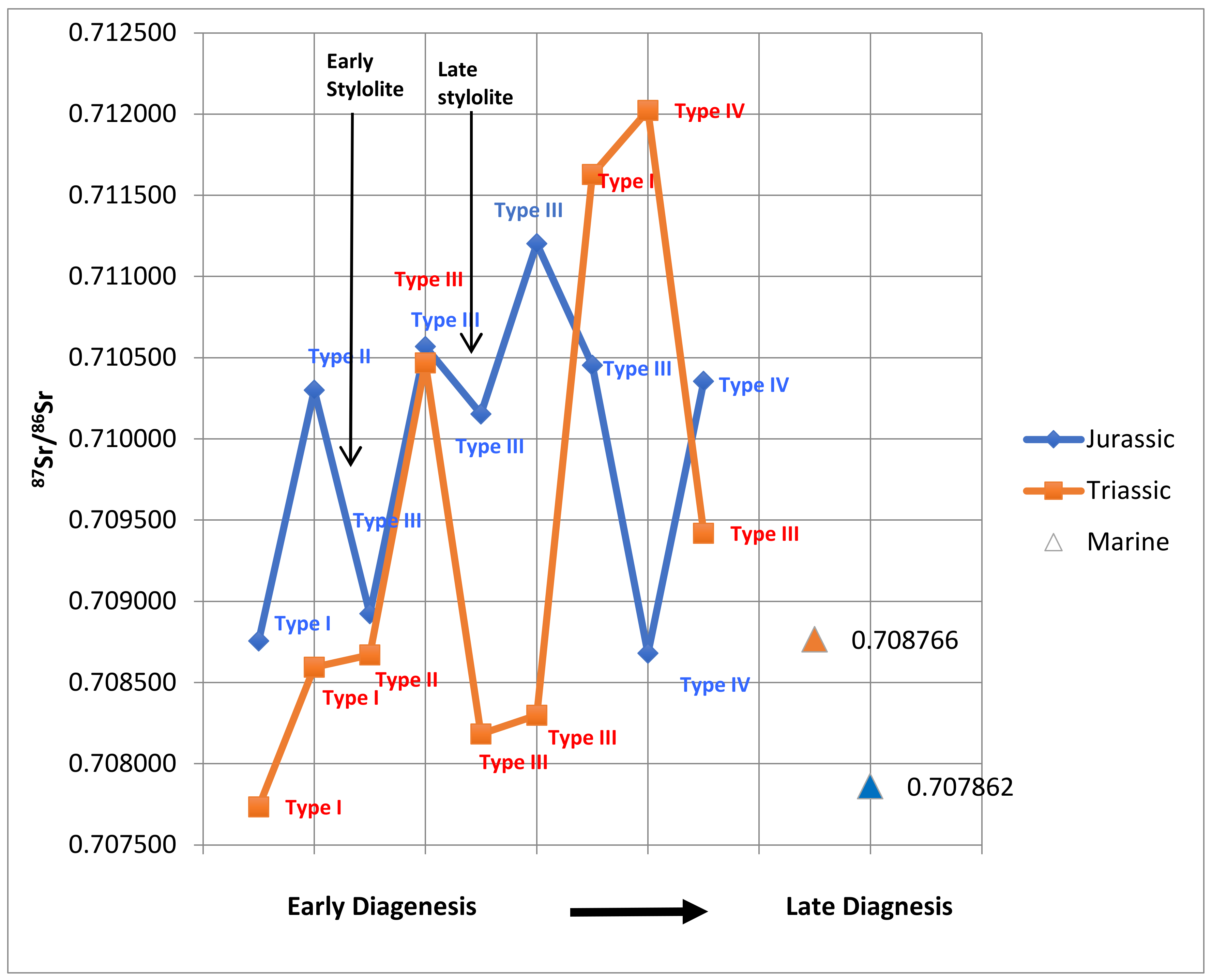
| Sample No. | Type | Mn (ppm) | Fe (ppm) | Ba (ppm) | Sr (ppm) | Mg (wt. %) | Ca (wt. %) | Ca (wt. %)/ Mg (wt. %) |
|---|---|---|---|---|---|---|---|---|
| NM4 | Type III | 147 | 433 | 3 | 125 | 12.7 | 21.8 | 1.7 |
| NM8 | Type IV | 13 | 27 | 4 | 291 | 0.5 | 39.4 | 86.0 |
| NM10a | Type II | 34 | 152 | 3 | 60 | 12.8 | 21.9 | 1.7 |
| NM12 | Type II | 37 | 78 | 6 | 197 | 11.4 | 23.7 | 2.1 |
| NM16 | Type II | 108 | 317 | 4 | 134 | 12.1 | 22.7 | 1.9 |
| NM23 | Type I | 110 | 1991 | 2 | 73 | 12.4 | 21.5 | 1.7 |
| NM23 | Type III | 66 | 1076 | 2 | 106 | 11.9 | 22.7 | 1.9 |
| NM28 | Type I | 107 | 718 | 4 | 83 | 12.7 | 21.8 | 1.7 |
| NM30 | Type IV | 146 | 204 | 3 | 368 | 0.6 | 38.9 | 68.0 |
| NM34 | Type III | 91 | 282.3 | 2 | 86 | 11.5 | 23.4 | 2.0 |
| NM4 | Type III | 140 | 441 | 3 | 61 | 12.2 | 20.6 | 1.7 |
| NM21 | Type III | 226 | 730 | 4 | 180 | 11.9 | 21.8 | 1.8 |
| NM22 | Type III | 40 | 168 | 3 | 103 | 12.6 | 21.8 | 1.7 |
| NM11 | Type I | 51 | 463 | 2 | 83 | 11.4 | 22.1 | 1.9 |
| NM34 | Type III | 61 | 291 | 1 | 79 | 11.4 | 21.9 | 1.9 |
| NM32 | Type II | 60 | 337 | 2 | 47 | 12.3 | 21.2 | 1.7 |
| NM23 | Type III | 149 | 1225 | 8 | 257 | 10.8 | 23.1 | 2.1 |
| NM44 | Lst-Triassic | 113 | 1309 | 2 | 79 | 12.2 | 20.4 | 1.7 |
| NM39 | Lst-Jurassic | 10 | 154 | 3 | 127 | 0.3 | 37.8 | 135.5 |
| Age | Sample No. | Type | δ13C | δ18O | Sr87/Sr86 |
|---|---|---|---|---|---|
| (‰ VPDB) | (‰ VPDB) | ||||
| Upper Jurassic | NM1 | Type III | 1.72 | −9.09 | |
| NM2 | Type II | 1.78 | −8.25 | ||
| NM3 | Type III | 1.46 | −9.35 | ||
| NM3 | Type III | 1.78 | −9.94 | ||
| NM3 | Type II | 2.06 | −8.03 | ||
| NM4 | Type I | 1.81 | −6.44 | ||
| NM5 | Type I | 1.74 | −7.07 | ||
| NM5 | Type II | 1.76 | −7.85 | ||
| NM5 | Type III | 1.83 | −9.99 | ||
| NM6 | Type I | 2.04 | −4.87 | ||
| NM7 | Type III | 1.69 | −9.82 | ||
| NM7 | Type III | 1.72 | −9.43 | ||
| NM7 | Type III | 1.72 | −9.83 | ||
| NM8 | Type III | 1.81 | −8.75 | ||
| NM8 | Type III | 1.63 | −9.61 | ||
| NM8 | Type IV | 0.38 | −11.83 | 0.70868 | |
| NM9 | Type III | 1.81 | −10.86 | ||
| NM10a | Type II | 1.55 | −8.02 | 0.71030 | |
| NM10b | Type II | 1.44 | −8.18 | 0.710552 | |
| NM11 | Type III | 1.48 | −10.78 | ||
| NM11 | Type III | 2.07 | −10.56 | ||
| NM12 | Type III | 1.78 | −9.14 | ||
| NM13 | Type III | 1.76 | −9.28 | ||
| Upper Jurassic | NM14 | Type IV | −0.59 | −11.12 | |
| NM14 | Type IV | −0.02 | −9.98 | 0.710355 | |
| NM15 | Type III | 1.85 | −9.42 | ||
| NM15 | Type III | 1.86 | −9.71 | 0.710154 | |
| NM16 | Type I | 1.76 | −6.31 | 0.708757 | |
| NM16 | Type III | 1.42 | −9.65 | ||
| NM17 | Type III | 1.79 | −9.31 | ||
| NM17 | Type III | 1.8 | −9.47 | ||
| NM18 | Type IV | 0.92 | −10.42 | ||
| NM18 | Type III | 1.59 | −10.26 | ||
| NM18 | Type III | 1.57 | −9.66 | ||
| NM19 | Type III | 1.57 | −9.72 | 0.711203 | |
| NM19 | Type III | 1.48 | −9.23 | ||
| NM20 | Type IV | 0.98 | −9.62 | ||
| NM20 | Type IV | −0.15 | −10.52 | ||
| NM20 | Type III | 1.29 | −9.31 | ||
| NM21 | Type III | 1.61 | −11.63 | 0.710609 | |
| NM21 | Type I | 1.98 | −6.82 | ||
| NM22 | Type III | 1.82 | −9.05 | 0.708879 | |
| NM22 | Type III | 1.84 | −9.45 | ||
| NM22 | Type III | 1.83 | −9.37 | ||
| Triassic | NM23 | Type II | 2.3 | −6.2 | |
| NM23 | Type II | 2.3 | −6.8 | ||
| NM24 | Type III | 2.3 | −9.98 | ||
| NM24 | Type III | 1.97 | −9.09 | ||
| NM25 | Type III | 2.56 | −9.86 | ||
| NM27 | Type II | 2.31 | −7.58 | ||
| NM27 | Type III | 2.21 | −8.28 | 0.708299 | |
| NM27 | Type II | 2.21 | −7.48 | ||
| NM26 | Type I | 1.98 | −5.7 | ||
| NM26 | Type I | 1.31 | −6.44 | 0.707735 | |
| NM28 | Type III | 2.54 | −8.51 | ||
| NM28 | Type III | 1.46 | −9.35 | ||
| NM29 | Type II | 2.2 | −6.67 | 0.708671 | |
| NM30 | Type IV | 0.65 | −14.14 | 0.712023 | |
| NM31 | Type III | 2.11 | −8.44 | ||
| NM32 | Type III | 2.2 | −8.57 | ||
| NM32 | Type III | 2.02 | −9.91 | ||
| NM33 | Type III | 2.49 | −8.74 | ||
| NM33 | Type III | 2.03 | −9.44 | 0.70942 | |
| NM34 | Type III | 1.81 | −9.63 | ||
| NM34 | Type II | 1.97 | −7.93 | ||
| NM34 | Type III | 2 | −9.16 | 0.708184 | |
| NM35 | Type III | 2.26 | −9.07 | ||
| NM35 | Type IV | 2.09 | −12.08 | ||
| NM36 | Type I | 0.21 | −7.35 | 0.708595 | |
| NM36 | Type I | 0.93 | −7.35 | 0.711628 | |
| NM37 | Type III | 1.16 | −10.35 | 0.710469 | |
| Upper Jurassic | NM38 | Limestone | 2.07 | −2.33 | |
| NM39 | Limestone | −0.53 | −4.21 | 0.707862 | |
| Triassic | NM40 | Limestone | 1.54 | −2.31 | |
| NM41 | Limestone | 1.73 | −2.5 | ||
| NM42 | Limestone | 1.88 | −3.36 | ||
| NM43 | Limestone | 1.98 | −1.67 | ||
| NM44 | Limestone | 2.53 | −2.37 | 0.708766 | |
| NM45 | Limestone | 2.31 | −3.36 | ||
| NM46 | Limestone | 3.05 | −0.23 | ||
| NM47 | Limestone | 2.71 | −3.25 |
© 2020 by the authors. Licensee MDPI, Basel, Switzerland. This article is an open access article distributed under the terms and conditions of the Creative Commons Attribution (CC BY) license (http://creativecommons.org/licenses/by/4.0/).
Share and Cite
Salih, N.; Mansurbeg, H.; Préat, A. Geochemical and Dynamic Model of Repeated Hydrothermal Injections in Two Mesozoic Successions, Provençal Domain, Maritime Alps, SE-France. Minerals 2020, 10, 775. https://doi.org/10.3390/min10090775
Salih N, Mansurbeg H, Préat A. Geochemical and Dynamic Model of Repeated Hydrothermal Injections in Two Mesozoic Successions, Provençal Domain, Maritime Alps, SE-France. Minerals. 2020; 10(9):775. https://doi.org/10.3390/min10090775
Chicago/Turabian StyleSalih, Namam, Howri Mansurbeg, and Alain Préat. 2020. "Geochemical and Dynamic Model of Repeated Hydrothermal Injections in Two Mesozoic Successions, Provençal Domain, Maritime Alps, SE-France" Minerals 10, no. 9: 775. https://doi.org/10.3390/min10090775
APA StyleSalih, N., Mansurbeg, H., & Préat, A. (2020). Geochemical and Dynamic Model of Repeated Hydrothermal Injections in Two Mesozoic Successions, Provençal Domain, Maritime Alps, SE-France. Minerals, 10(9), 775. https://doi.org/10.3390/min10090775







